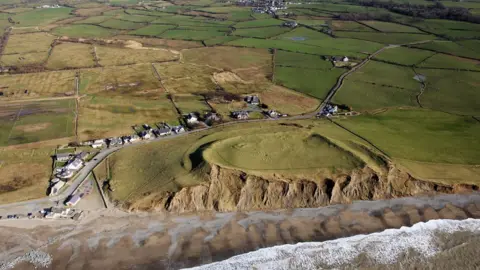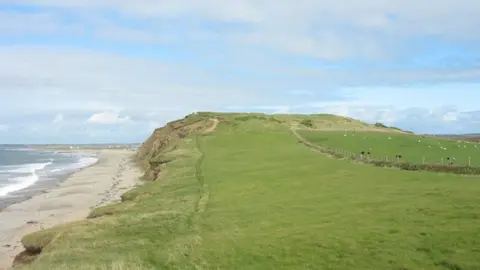Dinas Dinlle dig uncovers Iron Age roundhouse and Roman coins
 Crown Copyright
Crown CopyrightA huge Iron Age roundhouse, thought to be about 2,500 years old, and roman pottery have been uncovered during an archaeological dig at a coastal fort.
Volunteers have joined experts to find out more about the little-known Dinas Dinlle National Trust-owned monument in Gwynedd before it falls into the sea.
The 43ft (13m) wide roundhouse was buried by coastal sand, thought to have blown there during a sandstorm in 1330.
Coins found at the fort near Caernarfon suggest it was occupied in Roman times.
The "well-preserved" roundhouse - with its 8ft (2.5m) thick walls - was uncovered close to the cliff edge buried underneath 3ft (1m) of sand during a two-week dig.
"It's probably the biggest one I've ever seen in 30 years of archaeology," said David Hopewell, senior archaeologist at the dig.
"In another trench we have another big wall which may be another roundhouse but we're not entirely sure yet.
"The main problem is that everything is under a metre of sand and we're wondering if it blew in in the big storm in 1330 - so it looks like it's been buried for a long time and it's superbly preserved."
Archaeologists' initial estimations think the Roman pottery could be from around 200 to 300AD while the fort is thought to be from the Iron Age, which dates from around 800BC to 43AD.
"That's not to say Romans occupied the site but perhaps a tribe lived there that traded with the Romans," said Dan Amor, of the Gwynedd Archaeological Trust.
 Gwynedd Archaeological Trust
Gwynedd Archaeological TrustThe roundhouse, though, could be the jewel in the crown of the hillfort - set on glacial drift sediment - of which about 30% already been lost to the Irish Sea since 1900.
Experts predict, due to climate change, the 125-acre Dinas Dinlle site could be completely lost within 500 years.
It is one of 12 sites in the UK and Ireland being monitored by the European Union-funded Cherish project, led by the Royal Commission, to see how climate change is affecting coastal heritage such as Dinas Dinlle.
 Eric Jones/Geograph
Eric Jones/GeographThis is the first archaeological excavation of the hillfort that formed part of a golf course in the early 20th Century before a pill box was constructed on the site during the Second World War.
Early maps and the curve of the defences suggest the fort was once entirely enclosed but part of the western defences have been lost to the sea following thousands of years of coastal erosion.
"Dinas Dinlle encapsulates the risk to our coastline from climate change," said Andy Godber of the National Trust.
"Our coastal adaptation policy for Dinas Dinlle is to accept the loss of this important site, being part of this innovative project allows us to learn more about the history of human occupation here, while we still can."
